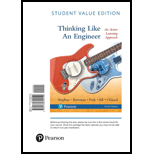
Concept explainers
Write the MATLAB code necessary to create the variables in (a) through (d) or calculate the vector computations in (e) through (q). If a calculation is not possible, explain why. You may assume that the variables created in parts (a) through (d) are available for the remaining computations in parts (e) through (q). For parts (e) through (q) when it is possible, determine the expected result of each computation by hand.
a. Save vector [3 –2 5] in va
b. Save vector
c. Save vector [9 –4 6 –5] in vc.
d. Save vector
e. Convert vd to a row vector and store in variable ve.
f. Place the sum of the elements in Va in the variable S1.
g. Place the product of the last three elements of vd in the variable P1.
h. Place the cosines of the elements of vb in the variable c1. Assume the values in vb are angles in radians.
i. Create a new 14-element row vector V19 that contains all of the elements of the four original
j. Create a two-element row vector v2 that contains the product of the first two elements of vc as the first element and the product of the last two elements of vc as the second element.
k. Create a two-element column vector v2A that contains the sum of the odd-numbered elements of vc as the first element and the sum of the even-numbered elements of vc as the second element.
l. Create a row vector ES1 that contains the element-wise sum of the corresponding values in vc and vd.
m. Create a row vector DS9 that contains the element-wise sum of the elements of vc with the square roots of the corresponding elements of vd.
n. Create a column vector EP1 that contains the element-wise product of the corresponding values in va and vb.
o. Create a row vector ES2 that contains the element-wise sum of the elements in vb with the last three elements in vd.
p. Create a variable s2 that contains the sum of the second elements from all four original vectors, Va, vb, vc, and vd.
q. Delete the third element of vd, leaving the resulting three-element vector in vd.
Want to see the full answer?
Check out a sample textbook solution
Chapter 15 Solutions
Thinking Like An Engineer: An Active Learning Approach, Student Value Edition (4th Edition)
- (read image) (answer given)arrow_forwardA cylinder and a disk are used as pulleys, as shown in the figure. Using the data given in the figure, if a body of mass m = 3 kg is released from rest after falling a height h 1.5 m, find: a) The velocity of the body. b) The angular velocity of the disk. c) The number of revolutions the cylinder has made. T₁ F Rd = 0.2 m md = 2 kg T T₂1 Rc = 0.4 m mc = 5 kg ☐ m = 3 kgarrow_forward(read image) (answer given)arrow_forward
- 11-5. Compute all the dimensional changes for the steel bar when subjected to the loads shown. The proportional limit of the steel is 230 MPa. 265 kN 100 mm 600 kN 25 mm thickness X Z 600 kN 450 mm E=207×103 MPa; μ= 0.25 265 kNarrow_forwardT₁ F Rd = 0.2 m md = 2 kg T₂ Tz1 Rc = 0.4 m mc = 5 kg m = 3 kgarrow_forward2. Find a basis of solutions by the Frobenius method. Try to identify the series as expansions of known functions. (x + 2)²y" + (x + 2)y' - y = 0 ; Hint: Let: z = x+2arrow_forward
- 1. Find a power series solution in powers of x. y" - y' + x²y = 0arrow_forward3. Find a basis of solutions by the Frobenius method. Try to identify the series as expansions of known functions. 8x2y" +10xy' + (x 1)y = 0 -arrow_forwardHello I was going over the solution for this probem and I'm a bit confused on the last part. Can you please explain to me 1^4 was used for the Co of the tubular cross section? Thank you!arrow_forward
- Blood (HD = 0.45 in large diameter tubes) is forced through hollow fiber tubes that are 20 µm in diameter.Equating the volumetric flowrate expressions from (1) assuming marginal zone theory and (2) using an apparentviscosity for the blood, estimate the marginal zone thickness at this diameter. The viscosity of plasma is 1.2 cParrow_forwardQ2: Find the shear load on bolt A for the connection shown in Figure 2. Dimensions are in mm Fig. 2 24 0-0 0-0 A 180kN (10 Markarrow_forwarddetermine the direction and magnitude of angular velocity ω3 of link CD in the four-bar linkage using the relative velocity graphical methodarrow_forward
 Elements Of ElectromagneticsMechanical EngineeringISBN:9780190698614Author:Sadiku, Matthew N. O.Publisher:Oxford University Press
Elements Of ElectromagneticsMechanical EngineeringISBN:9780190698614Author:Sadiku, Matthew N. O.Publisher:Oxford University Press Mechanics of Materials (10th Edition)Mechanical EngineeringISBN:9780134319650Author:Russell C. HibbelerPublisher:PEARSON
Mechanics of Materials (10th Edition)Mechanical EngineeringISBN:9780134319650Author:Russell C. HibbelerPublisher:PEARSON Thermodynamics: An Engineering ApproachMechanical EngineeringISBN:9781259822674Author:Yunus A. Cengel Dr., Michael A. BolesPublisher:McGraw-Hill Education
Thermodynamics: An Engineering ApproachMechanical EngineeringISBN:9781259822674Author:Yunus A. Cengel Dr., Michael A. BolesPublisher:McGraw-Hill Education Control Systems EngineeringMechanical EngineeringISBN:9781118170519Author:Norman S. NisePublisher:WILEY
Control Systems EngineeringMechanical EngineeringISBN:9781118170519Author:Norman S. NisePublisher:WILEY Mechanics of Materials (MindTap Course List)Mechanical EngineeringISBN:9781337093347Author:Barry J. Goodno, James M. GerePublisher:Cengage Learning
Mechanics of Materials (MindTap Course List)Mechanical EngineeringISBN:9781337093347Author:Barry J. Goodno, James M. GerePublisher:Cengage Learning Engineering Mechanics: StaticsMechanical EngineeringISBN:9781118807330Author:James L. Meriam, L. G. Kraige, J. N. BoltonPublisher:WILEY
Engineering Mechanics: StaticsMechanical EngineeringISBN:9781118807330Author:James L. Meriam, L. G. Kraige, J. N. BoltonPublisher:WILEY





